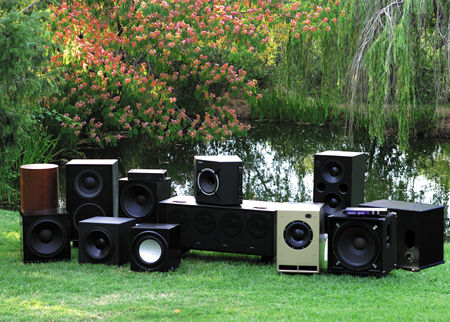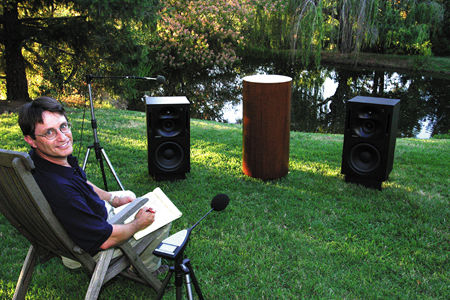Way Down Deep I
Details on the testing methodology can be found here.
Part Two of this article can be found here.
Part Three of this article can be found here.

It was the year after high school, and I was casting about for something to do when a distant relative in Fresno got me a summer job "lumping." A lumper schleps boxes out of big trucks and stacks them on pallets. The orders are barked out and you hustle back and forth, from semi to loading dock, over and over, groaning in 112° heat. When you catch your breath, you shout "Right away, sir!" to a bare-chested gentleman slouching in the shade, his face creased by a scowl relieved only by the inscrutable tattoo on his forehead. My third day on the job, I spent my lunch break in a phone booth, dialing college admissions officers to see if by chance there might still be an open slot for the fall semester.
If audio components could get together and talk, as in Toy Story, the word they'd use for lumping would be "subwoofing." A subwoofer hauls great quantities of stuff—air—from point A to point B, back and forth, to orders issued by a humorless brute known as a power amplifier. It's unrelenting donkey work, the least glamorous assignment in all of home entertainment. But if, as someone once said, all work is honorable, it could be argued that the work done by subwoofers is doubly so because it underpins the very success of the movie experience. This may seem like a highfalutinclaim for contraptions so lo-tech you can actually hear most of 'em groan as they work, but consider what's at stake from the filmmakers' perspective:
• The kinetic dimension—those booms, blasts, roars, crunches, slams, and thuds that foster a physical, even tactile engagement with the movie;
• The spatial context—the sense of place (think of the bass reverberation cues that place you in a giant cavern in the Bridge of Khazad-dm scene in The Lord of the Rings: The Fellowship of the Ring);
• The sense of materiality—many broad-spectrum environmental sounds (e.g., wind, earthquakes, thunder, trains, jets, cars) have their root energy in the deep bass, below 40Hz; without that low-end foundation, they can sound hollow, untrue, even hokey; and
• The emotional dimension—the last time a movie made the hairs on the back of your neck stand on end, it could well have been a sinister rumble or otherworldly hum that set you up for danger ahead.
With the stakes so high and the job description so, well, uncomplicated, you'd think that getting the bass right would be a matter of sizing up the field and picking the strongest donkey for the job. You'd be mistaken: Great bass is not a product of the right subwoofer, it's the product of the right process. That process can begin only when you realize that a subwoofer driver energizes two distinct enclosures: the one that houses it, and the one that houses you. The latter is beyond the scope of this review. For now, just consider that one of the two acoustic chambers I'm talking about received a fraction of the engineering attention, was built of acoustically sub-par materials, is many times larger than the other, and, worst of all, is the one in which your ears are located.
Nevertheless, like other A/V devices, every subwoofer falls somewhere along a performance continuum. In this six-month-long undertaking, I set out to probe the limits of as many of the best subwoofers in current production I could round up. My mission was to generate valid, repeatable, product-specific findings—information that would be more useful in characterizing a subwoofer's performance than typical magazine reviews, grapevine buzz, showroom demos, or manufacturer white papers.

I started by making a list of more than two dozen subs that intrigued me, and I invited their makers to send me a production sample for one of the more rigorous comparison tests ever to appear in print. Initially, manufacturer response was uniformly enthusiastic. But after I'd described the test regimen (see the "Test Methodology" sidebar), many of them figured out a way to extricate themselves before the guy in the shipping department could type up the address label. In the end, however, an adventuresome group did step forward, either because they knew what their units were really made of, or because they were curious enough to risk a little unpleasantness to find out.
Disclaimer time: In my business of designing home theaters and listening rooms, I've recommended a number of the subwoofers reviewed in this feature, but I have no financial stake, direct or indirect, in their sale; my company is a design, engineering, testing, and calibration service that leaves sales and installation to the homeowner's AV contractor.
Here, then, is the first installment, a story of four active subwoofers whose makers weighed the risks and said, "We like our chances." Any parametric equalization, where available, was switched out for all measurements and listening tests. Lowpass filters were disengaged, where possible, for the measurements. All output levels are specified in decibels (dB), which I have used as shorthand for dB SPL.
Note: Figs. A1 through D5
Technically referred to as spectrograms, the waterfall graphs shown here provide a picture of how deep and loud each subwoofer managed to play several particularly treacherous 10/15-second clips from a few selected soundtracks and CDs. The main speakers were disconnected and the subwoofer level increased to a point just 1dB below the onset of audible distortion—whether hashiness, fuzziness, fluttery noises, cardboardy thwock sounds, or other noticeable fault. The result was recorded with the microphone 2m away from the subwoofer. In these displays, time flows downward, like water, with each faint white horizontal line marking 1 second. The frequency range spans from 0Hz on the far left to 80Hz on the far right. The color indicates playback volume over a 40dB range, from dark blue (very soft), increasing through green, yellow, and finally to burgundy (very loud).























































